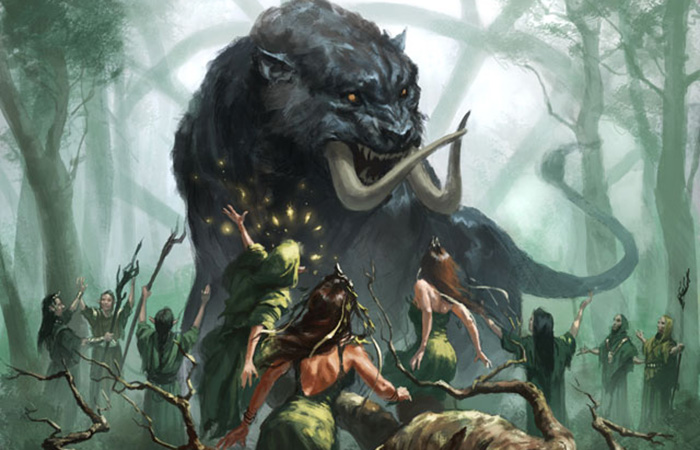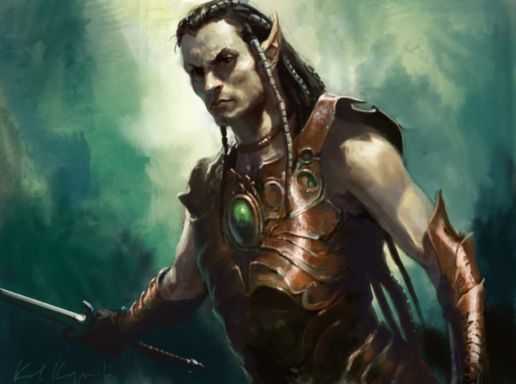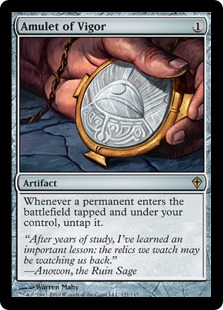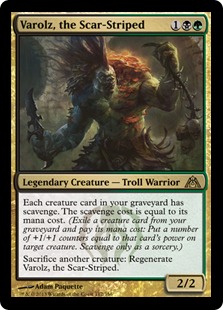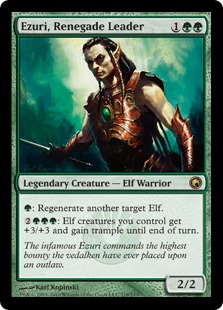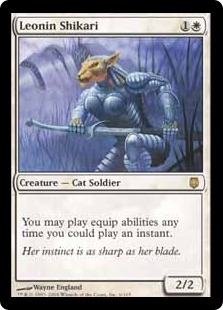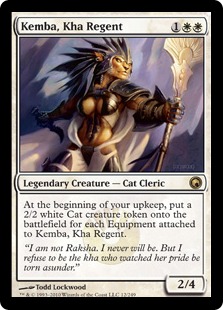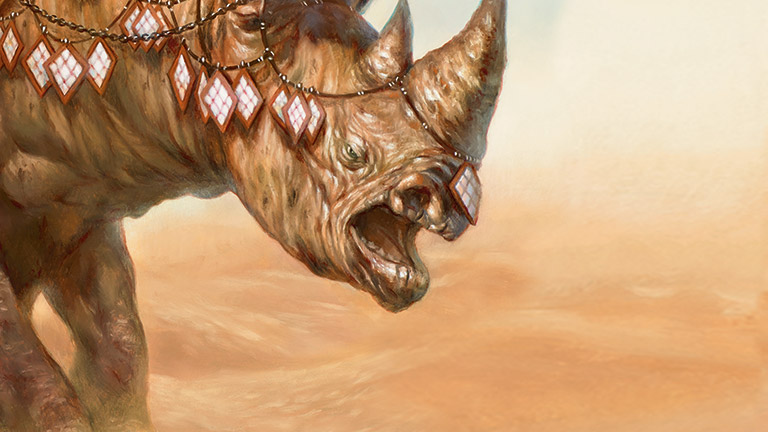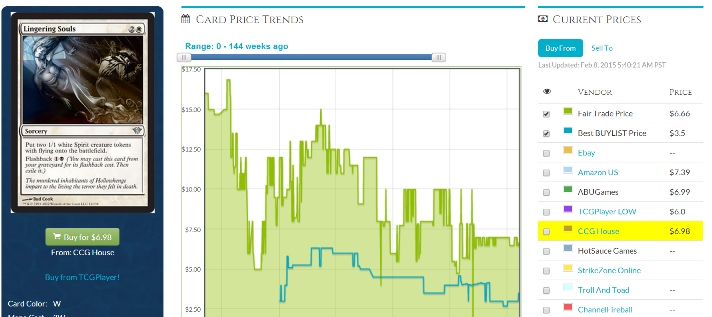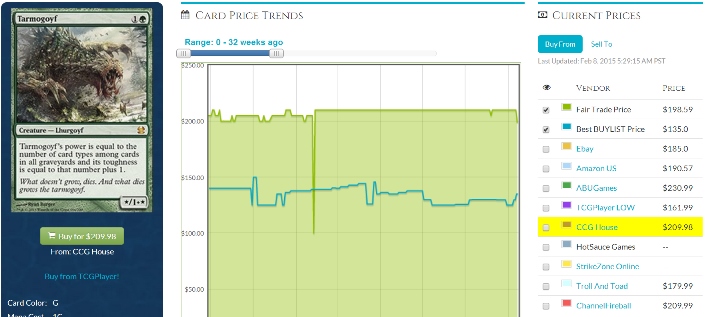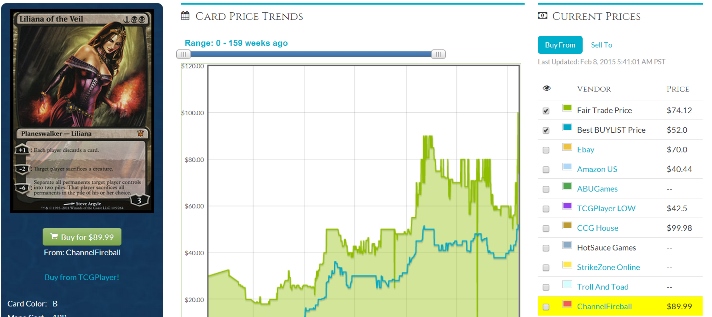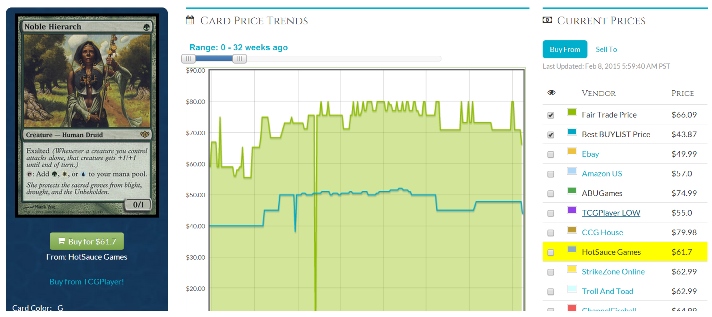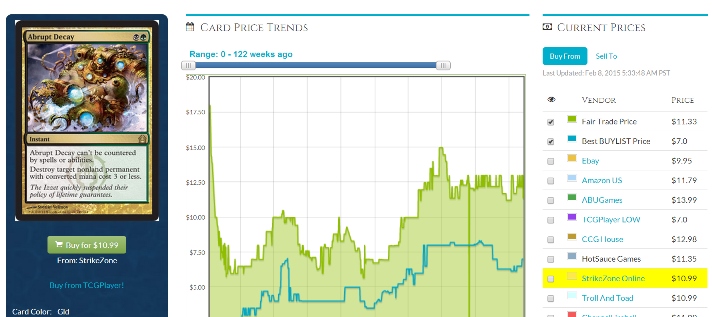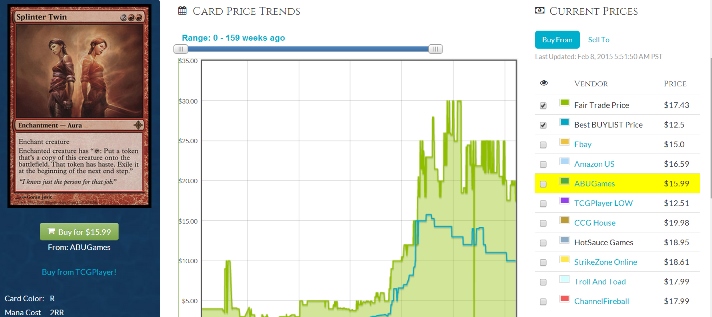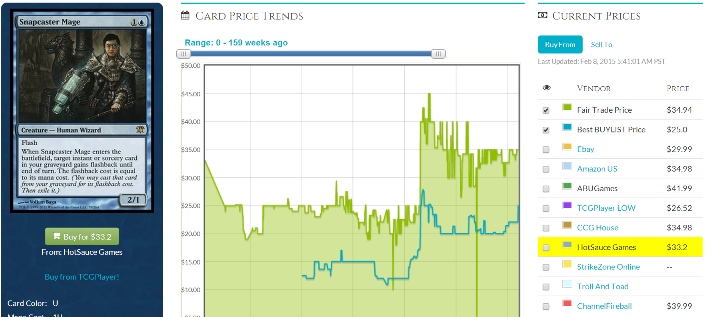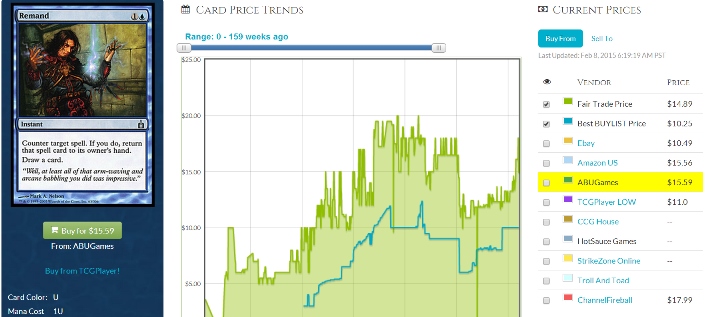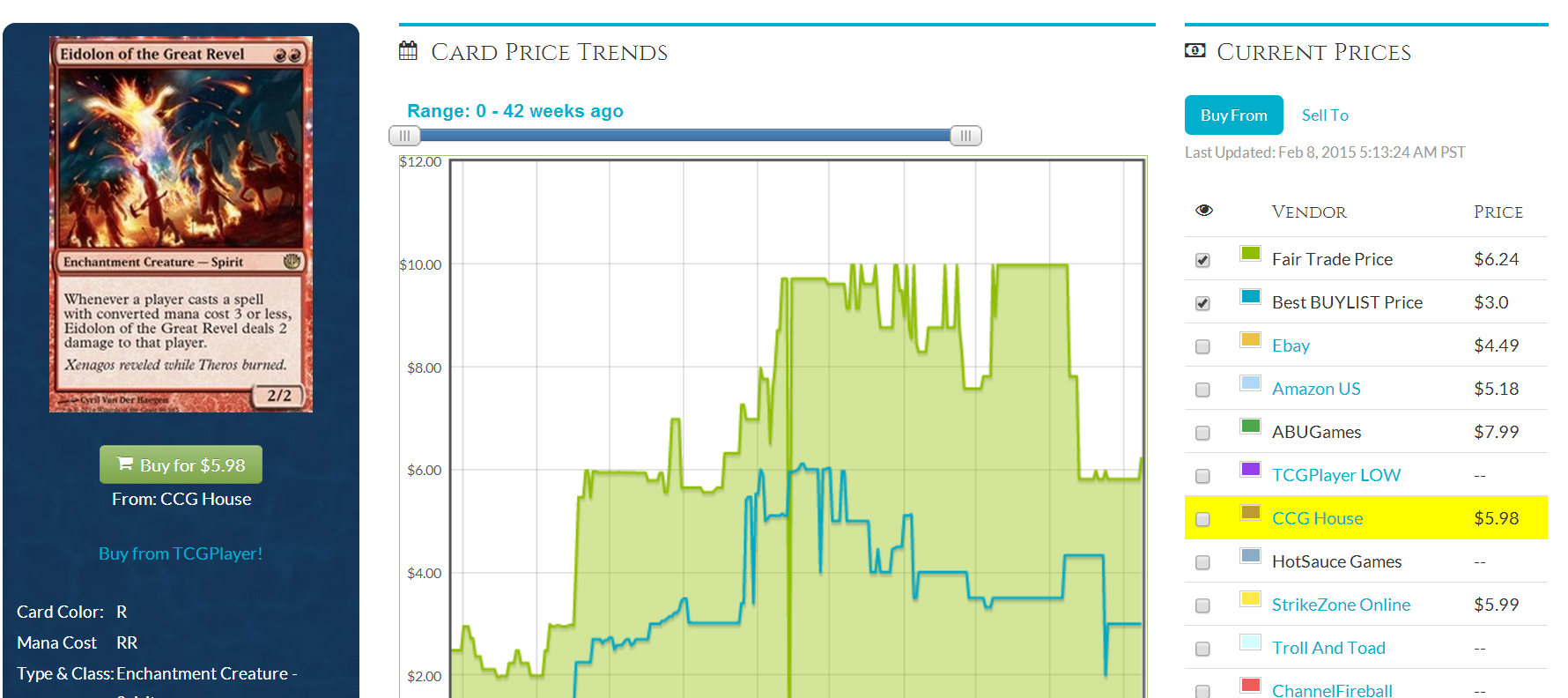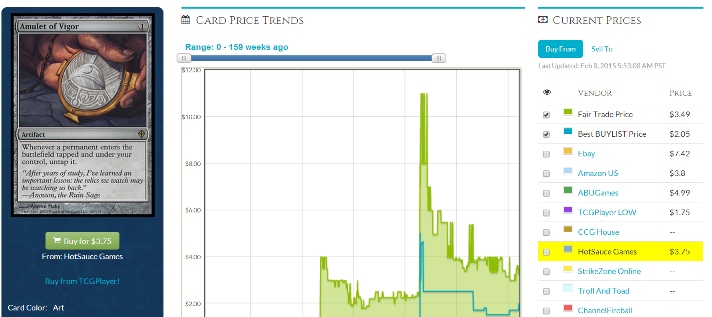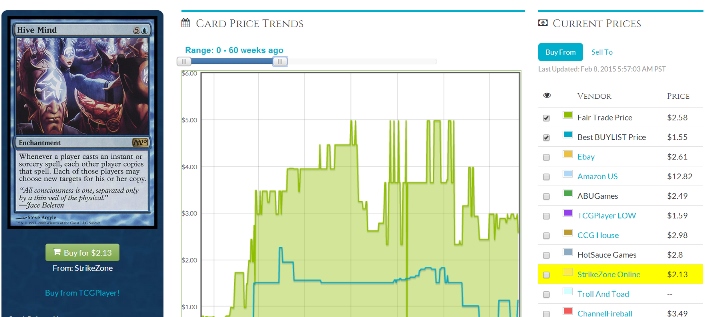By James Chillcott (@MTGCritic)
One of the most common misconceptions about folks involved in MTGFinance is that we are constantly manipulating the market and feeding players misinformation to help fuel achievement of our personal goals.
Having been squarely inside the scene for a while now, it’s become crystal clear that while there is plenty of manipulation going on, very little of it has anything to do with the people whose articles you are reading every week on the various blogs and vendor sites. In fact, most of my research seems to point at mid-level vendors as the biggest instigators of the various buyouts and attempted pump and dump schemes, along with a shadowy and constantly shifting melange of players from across the globe who make little noise while they are making their plays. Most of the writer’s I know on the other hand, tend to either talk about more cards than they buy, or simply do their best to buy good cards at the right time and let other’s in on the play as part of their role in the community.
It recently occurred to us here that though we dole out a good deal of advice, most of you ultimately have very little insight into when we actually put our money where our collective mouths are pointing. As such we’ve decided to run a weekly series simply breaking down what we’ve been buying this week and why. These lists are meant to be both complete and transparent, leaving off only cards we bought without hope of profit, where appropriate. We’ll also try to provide some insight into our thinking behind the specs, and whether we are aiming for a short (<1 month), mid (1-12 month), or long (1 year+) term flip. Here we go!
Buying Period: Feb 8th – 14th, 2015
- Mid: 3x Eidolon of the Great Revel (NM – Foil): $21 per
- Mid: 5x Amulet of Vigor (NM – Foil): $12 per
- Mid: 8x Amulet of Vigor (NM – Foil): $9.50 per
- Mid: 14x Amulet of Vigor (NM): $4.00 per
- Mid: 9x Humble Defector (NM – Foil): $5.25 per
- Mid: 18x Gurmag Angler (NM – Foil): $0.80 per
- MId: 4x Lingering Souls (NM – Foil): $5.75 per
- Mid: 4x Leonin Shakiri (NM): $5 per
- Mid: 3x Stubborn Denial (NM – Foil): $3.50 per
- Mid: 3x Anafenza, the Foremost (NM – Foil): $12 per
- Long: 2x Voice of Resurgance (NM): $14.40 per
- Long: 2x Tasigur, The Golden Fang (NM – Foil Promo): $20 per
- Long: 33x Seance (NM): $0.24 per
- Long: 44x Chord of Calling: $2.45 per
- Long: 7x Russian Fate Reforged Booster Box: $109 per
I’m currently aggressively adding to my holdings as I believe that despite relatively flat player growth, well designed set releases and constantly shifting metagames in 2015 are likely to drive strong sales and open up opportunities for undervalued cards to achieve solid growth. I further believe that the death of Modern is greatly exaggerated and with Modern Masters 2 just a few months off, interest in the format is likely to stay steady throughout the year.
Amulet of Vigor, Gurmag Angler, Stubborn Denial, Eidolon of the Great Revel and Tasigur, the Golden Fang were all positions I added to after seeing their potential early on at Pro Tour Fate Reforged last week. Of those cards Eidolon and Tasigur are the sure bets, with regular versions of Eidolon and foil versions of Tasigur being the best plays. Amulet is currently holding steady near it’s Pro Tour hype spike and I believe that far more players are interested in the deck after seeing it perform so well (even with mediocre draws) on camera. Amulet also holds potential in other decks down the road.
Stubborn Denial foils are bound to increase, as the card is possibly playable back to Legacy, especially given that some version of the Delve archtype brought to the Pro Tour by Patrick Chapin is likely to find Tier 2 status in Modern and/or Legacy once it has been refined. Chapin did terribly with the deck at PTFRF, but I’ve been running an adjusted version with 12x 4+ Power Delve creatures + 3x Glimpse the Unthinkable on MTGO this week with solid results. Hence the Gurmag Angler pickups, which are low risk with great upside if the card finds a permanent home in the archetype.
Lingering Souls is a key card in Modern at present, and despite multiple printings in non-foil, the only foils are still the Dark Ascension pack foils and the FNM promo. Anafenza foils and the pile of Chord of Callings I picked up are plays on Tiny Leaders gaining momentum, though I also believe Chord is only a few cards away from finding a new foundation in Modern and heading back north of $10. Seance and Humble Defector fall into my “just waiting to be broken” category, with Defector already showing up in Grixis Twin variants in Modern and seeing play in Standard G/R decks.
Finally, I’m a huge believer that Fate Reforged will be opened far less than Khans of Tarkir and Dragons of Tarkir, both because of the short shelf time between the 2nd and 3rd sets this year, and because it’s a small set with a lot of underrated cards set for long term growth potential. As such I am thrilled to be holding more than a case of Russian booster boxes, looking to exit over $250 within a few years as people chase foil Russian Ugin or Tasigur and the potential for “all-fetch” foreign fun.
Cliff Daigle (@WordofCommander)
- 2x Foreign White Border Scrubland (Italian/German): $55 per
Cliff says “I’d been looking for a chance to swap my Revised Scrubland out of my EDH deck, and the Italian worked out perfectly for that. Now I’ve got the German and the English copies ready for trade and I’m targeting a French Badlands.”
Note: Guo Heng Chin buys from Malyasia, so his costs will tend to be different than for those of us based in the west.
- 2x Ambassador Laquatus (NM – Foil): $2.49 per
- 1x Black Sun’s Zenith (NM – Game Day Promo): $6.99
- 2x Merieke Ri Berit (NM – Time Spiral): $0.59 per
- 2x Smother (NM – Foil): $1.49 per
- 16x Outpost Siege (NM): $0.49
Guo says:
“I mentioned in my article a while back that Ambassador Laquatus may be a good spec as he was touted as one of the tier one leaders in Tiny Leaders, and I meant it. It has yet to arrive (orders take a month to arrive at my treehouse in Malaysia) and he’s already doubled in price. Black Sun’s Zenith was another Tiny Leaders spec I highlighted in my article. I only snagged one copy as it was for personal use (Fun Police Control decks, here I come!) and my Magic budget is a bit tight this month, having just bought a GoPro Hero 4. I bought two Time Spiral Merieke Ri Berit. The foils were a little beyond my humble budget and I would have to make do with non-foil copies of this tier one control leader.
I bought two MP Onslaught Smother foils because in Tiny Leaders Smother reads “1B: Destroy any creature, it can’t be regenerated” Sounds good to me. Also, I have a fetish for old border foils, a proclivity I attribute to being exposed to Magic during Urza’s Destiny, when foils were called premium cards and were actually a rare sight.
Outpost Siege is my bet for the undervalued Fate Reforged rare that would break out: It’s a bloody Phyrexian Arena in Red for goodness sake. Apparently I am not the only one to think so.”
Jared Yost & Travis Allen
Nothing to report this week.
So there you have it. Now what were you guys buying this week and why?
James Chillcott is the CEO of ShelfLife.net, The Future of Collecting, Senior Partner at Advoca, a designer, adventurer, toy fanatic and an avid Magic player and collector since 1994.
ADVERTISEMENT: Get the Cube Starter Bundle with the 3rd Edition Grimoire Deck Box, the brand new Grimoire Deck Box designed specifically for the red mage in you.
